October 26, 2017 | Stephen Fine, Founder and President
Melanoma Mimics
Few health-related issues cause greater instantaneous anxiety and fear than suddenly discovering something new and unsightly on our skin. After the initial shock, it’s human nature for most people to immediately start thinking about worst-case scenarios.
However, there‘s no need to panic or jump to conclusions. The reason is that there are many scary-looking, yet benign, skin growths and blemishes that only mimic the appearance of melanoma. But that determination is not something anyone should ever try to make on his or her own, or through research on popular self-help, diagnostic-focused healthcare websites.
Either through visual inspection or biopsy, only a dermatologist is sufficiently trained to distinguish which skin issues may be cancerous and which are not. As time is of the essence with regard to diagnosing melanoma, any suspicious looking changes to the skin should be brought to the attention of a dermatologist as quickly as possible.
Look at Some Look-Alikes
To better illustrate the appearance of mimics, we’ll present six photographs of common skin conditions that have been mistaken for melanoma.
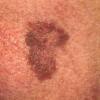
Solar Lentigo
These are more commonly known as age or liver spots. They’re benign, caused by sun exposure and primarily seen in older individuals.
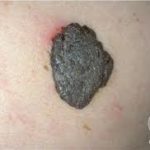
Seborrheic Keratosis
Often found on middle-aged or older adults, they’re benign, develop as black, tan or brown in color and look like they’ve been pasted on. Black seborrheic keratoses may occasionally be a sub-type of melanoma, and have the potential to degenerate into squamous cell carcinoma.
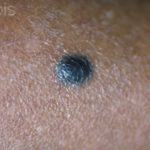
Blue Nevus
Benign and, aside from their blue/black appearance they’re no different from any other ordinary mole, and have no greater potential to turn cancerous.
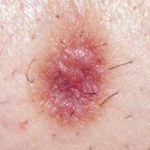
Dermatofibroma
These benign brown-to-red/purple growths are often caused by minor injuries, splinters or insect bites. They’re usually found on the arms and legs.
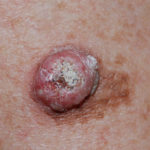
Keratoacanthoma
This common skin tumor originates within hair follicles, and is considered to be a low-grade squamous carcinoma.

Pyrogenic Granuloma
This benign blood-containing overgrowth may appear on skin or mucous membranes.
It’s important to remember that even if what’s been discovered is diagnosed as melanoma, if it’s caught and treated early enough this potentially lethal disease has nearly a 100% cure rate. So, if something on your skin doesn’t look right, get it checked out right away.
*Additional source articles: Melanoma Education Foundation (MEF) Fall 2015 newsletter
